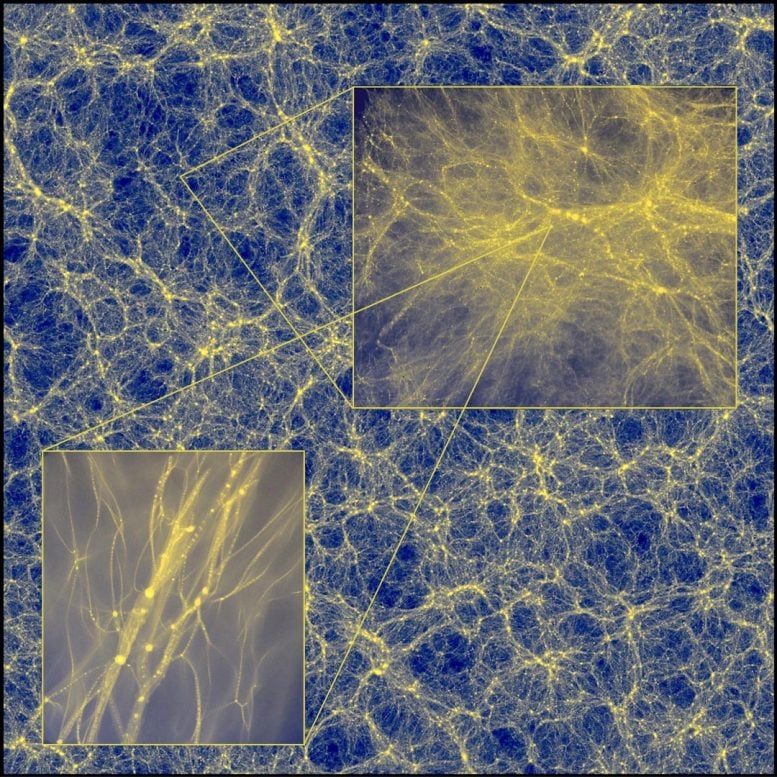An artist’s impression of halos made of dark matter with different masses in the universe. Photo credit: YU Jingchuan, Beijing Planetarium
Most of the matter in the universe is dark and inherently very different from the matter that stars, planets, and humans are made of. Galaxies form and grow when gas cools and condenses in the center of enormous clumps of this dark matter called halos of dark matter.
An international research team led by Prof. WANG Jie of the National Astronomical Observatories of the Chinese Academy of Sciences (NAOC) used supercomputers in China and Europe to zoom in on a typical region of a virtual universe, as if taking a picture of the moon to see a flea on its surface.
The study was published in nature on September 2, 2020.
The largest halos of dark matter in the universe today contain huge galaxy clusters, collections of hundreds of bright galaxies. The properties of such clusters, which weigh more than a quadrillion (one million billion) times as much as our sun, have been well studied.
On the other hand, the masses of the smallest dark matter halos are unknown. According to currently popular theories, it is believed to be the mass of the earth.
Such small halos would be extremely numerous and would contain a substantial part of all dark matter in the universe. However, they would remain dark throughout cosmic history, as stars and galaxies only grow in halos more than a million times as massive as the sun.
“These small halos can only be examined by simulating the evolution of the universe in a large supercomputer,” said Prof. WANG.

Simulations of the formation of halos from dark matter, the size of which ranges from Earth’s mass to galaxy clusters, find a universal halo density structure with a mass of 20 orders of magnitude. Photo credit: Dr. Sownak Bose, Center for Astrophysics, Harvard University
It took the research team at the National Observatory of the Chinese Academy of Sciences in China, Durham University in Great Britain, the Max Planck Institute for Astrophysics in Germany and the Center for Astrophysics in the USA five years to develop, test and test perform their cosmic zoom.
It enabled them to study the structure of dark matter halos of all masses between that of Earth and that of a large cluster of galaxies. In terms of number, the zoom covers a mass range from 10 to the power of 30 (ie a one followed by 30 zeros), which corresponds to the number of kilograms in the sun.
By zooming in on the virtual universe in such microscopic detail, the researchers were able to study the structure of halos made of dark matter, whose mass ranges from that of the Earth to a large cluster of galaxies.
“Surprisingly, we find that halos of all sizes have a very similar internal structure, ie they are extremely dense in the center, increasingly spreading and have smaller lumps that orbit in their outer regions,” said Prof. WANG. “Without a measuring scale, it was almost impossible to distinguish an image of a dark matter halo of a massive galaxy from one whose mass is a fraction of the Sun.”
Particles of dark matter can collide near the centers of light wells and, according to some theories, destroy themselves in an outburst of energetic (gamma) radiation.
Co-author Prof. Carlos Frenk of Durham University said, “By enlarging these relatively small halos of dark matter, we can calculate the amount of radiation expected from halos of different sizes.”
Most of this radiation would be emitted by halos of dark matter too small to accommodate stars, and future gamma-ray observatories could capture these emissions and make these small objects “visible” individually or collectively.
“This would confirm the hypothetical nature of dark matter, which may not be entirely dark after all,” said co-author Simon White of the Max Planck Institute for Astrophysics. “Our research sheds light on these little halos while we want to learn more about what dark matter is and what role it plays in the evolution of the universe.”
Read Zooming In Tight on Dark Matter to learn more about this research.
Reference: “Universal structure of dark matter halos over a mass range of 20 orders of magnitude” by J. Wang, S. Bose, CS Frenk, L. Gao, A. Jenkins, V. Springel and SDM White, September 2, 2020, nature.
DOI: 10.1038 / s41586-020-2642-9
The simulations were carried out on the Cosmology Machine supercomputers in Guangzhou, China, Durham, England, UK, and Munich, Germany.



